
How to:
Reference: |
The Join tool provides a graphical method for creating and manipulating Joins. You must specify a host file, then a cross-referenced file to create a join.
You create the Join as an object, separate from any other object or procedure. You are responsible for placing the Join object in the correct position within your procedure (that is, before a Define, Report, or Graph), and for running it. The Join remains active for the entire session, unless you explicitly clear it.
You can open the Join tool from either the toolbar or from a reporting tool. Before the tool opens, you will be asked to select a host file.
The Join tool displays both files and, ordinarily, a default Join, as shown in the following image.

 icon
in front of the field, and virtual fields have a define
icon
in front of the field, and virtual fields have a define  icon
in front of the field. A virtual field is a temporary field that
does not actually exist in the data source. Its value is computed
based on an expression you write. After it is created, the virtual
field is treated as if it were a field in the data source.
icon
in front of the field. A virtual field is a temporary field that
does not actually exist in the data source. Its value is computed
based on an expression you write. After it is created, the virtual
field is treated as if it were a field in the data source.When you access the Join tool, a toolbar opens below the title bar. You can access the following commands from the toolbar:
|
Button |
Command |
Description |
|---|---|---|
|
|
Save |
Saves the join. |
|
|
New Join |
Creates additional concurrent joins. Note: You may also select New Join from the right-click context menu in the Join window. |
|
|
Add File |
Selects a cross-referenced file to join to the host file you have already selected. Note: You may also select Add File from the right-click context menu in the Join window. |
|
|
Clear Join |
Launches the Join Clear window. Note: You may also select Clear Join from the right-click context menu in the Join window. |
|
|
Run Join |
Runs a join to check syntax. Note: You may also select Run from the right-click context menu in the Join window. |
|
|
Delete |
Deletes a selected object (table or join). |
|
|
Define Field |
Launches the Define dialog box to create a virtual field in the host file. |
|
|
Create/Edit Selection |
Launches the WHERE Expression Builder to create WHERE criteria and change the join type to a conditional join. This is enabled only when the host table is selected. |
|
|
Show/Hide Source Code |
Shows or hides the FOCUS code generated by the Join tool. This is enabled only when the Join link is selected. |
|
|
Toggle Auto Join |
Performs automatic joins within tables. |
|
|
Cascade |
Creates a cascade view of multiple joins (default). |
|
|
Horizontal Tile |
Splits the Join tool horizontally when working with multiple joins. |
|
|
Vertical Tile |
Splits the Join tool vertically when working with multiple joins. |
If you want to define a Join in a procedure:
The Procedure Viewer opens.
The Join tool opens showing a Fields window for the host file that you selected.
Tip: You may also right-click anywhere in the Join window and select Add File from the context menu.
A default Join is created if the host and cross-referenced files share appropriate fields. If a default Join is not created, follow the instructions in Customizing a Join to create your own.
Note: This procedure applies to creating a Join in the Managed Reporting environment.
The WebFOCUS Table List dialog box opens.
The Join tool opens showing a Fields window for the host file that you selected.
The WebFOCUS Table List opens again.
A default Join is created if the host and cross-referenced files share appropriate fields. If a default Join is not created, follow the instructions in Customizing a Join to create your own.

or
or
The Join Properties dialog box opens.
The Field list for each data source being joined displays the field names by default. To help you build meaningful joins you can add information about the listed fields.
The selected information categories appear as headings in the field list for each joined file. Details will appear if the corresponding information is included in the Master File.
| WebFOCUS |